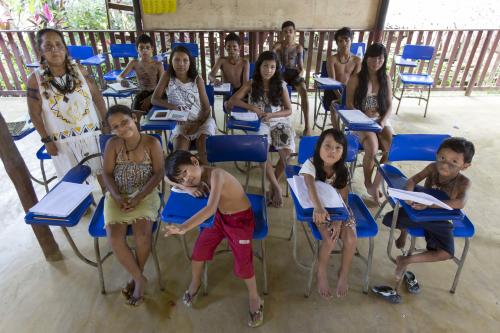In the 1980s, Latin America went through a decade long struggle with fiscal adjustment. Critics of adjustment programs pointed out that the poor paid a stiff price through higher inflation and lousier public services and infrastructure. Thirty years later, Brazil finds itself once again with a big fiscal deficit and rapidly rising public debt. What have we learned since then? What would a fair fiscal adjustment look like?
A team from the World Bank set out to answer these questions with a comprehensive review of public spending in Brazil. The new report, A Fair Adjustment, concludes that much of Brazil’s public spending benefits the relatively well off more than the poor, so there is room for serious fiscal adjustment without harming those most in need of government programs.
A leader in social policy innovation, a laggard in implementation
In the typical European country, public spending reduces the inequality of household incomes by more than a third. In Brazil the impact is less than a fifth (shown in several studies: Goñi, López and Servén, 2008; Higgins and Pereira, 2013; Lindert, 2017; Ministry of Finance of Brazil, 2017). Brazil should be held to the same standard because its tax-to-GDP ratio is about 33 percent, the same as that of the typical country in the Organization for Economic Cooperation and Development. Brazil has been an innovator in social policy: Conditional cash transfers—which aim to reduce poverty by making government help contingent upon receivers’ actions—were first introduced in Brazil. But while Brazil’s Bolsa Familia program is internationally acclaimed, it accounts for just half a percent of GDP.
A fair adjustment would reduce transfers to the better off, and could preserve—even increase—spending on such programs. The World Bank report shows that doing this could easily close Brazil’s gaping fiscal deficit. A fair adjustment would mean changing things in three areas: public pensions, government salaries, and benefits for big business.
The biggest source of savings is the country’s public pension system, which ran a deficit of nearly 4.5 percent of GDP last year. Brazil spends a lot more on social security than countries with much older populations (Figure 1). More than one-third of this gap is because of generous benefits to the richest 20 percent; more than four fifths of the deficit accrues to the top 60 percent (Figure 2). Another way would be to cut back on public sector pay which is 70 percent higher than private sector wages; the OECD average is 11 percent. Tax exemptions, interest subsidies, and direct transfers to business are a third area of potential savings. At 4.5 percent of GDP in 2016, they are almost 10 times the spending on Bolsa Familia.
Government benefits for the better off are also provided as tax benefits for private health insurance and in free public higher education, attended mainly by students from wealthier families. All in all, A Fair Adjustment report identified programs totaling some 8 percent of GDP, which could be cut back without hurting the poor. The savings could be used to restore fiscal balance and secure spending on tested social transfers and critical infrastructure investments.
Figure 1: Total pension expenditure in Brazil (RPPS and RGPS) as a share of GDP and dependency ratio
Source: World Bank, 2017
Figure 2: Incidence of subsidies from public pensions (RGPS and RPPS) across income quintiles of the Brazilian population
Source: World Bank, 2017
Who is actually poor?
Have these numbers convinced Brazilians that a fair adjustment is possible? Judging by the public reactions to the launch of the report, the answer is mixed. One criticism is that by focusing attention on the poor or bottom 40 percent, the report ignores the fact that even the relatively better off are quite vulnerable. A recent Oxfam survey found that almost 90 percent of all Brazilians believe they belong to the bottom half of society. There might a good reason for this. More than half of all households have an average per capita income below the minimum wage (880 Brazilian reals, or around $270), while fewer than 20 percent of households earn more than $500 per capita. If Brazil’s income distribution is so badly skewed, is it fair to ask the middle class to contribute to fiscal adjustment?
An international comparison of mean household incomes by decile puts Brazil’s income distribution in perspective (Figure 3). Compared with other countries, the very poor are poorer in Brazil and the very rich are much richer. Public perceptions of extreme inequality are not wrong.
Figure 3: Mean incomes by deciles relative to Brazil for select countries (2014 or latest year available)
Source: World Bank harmonized data from PovcalNet. The countries are Mexico, Colombia, Brazil, Chile, Bulgaria, Turkey, Croatia, Portugal, and Hungary.
A good debate to have this election year
Just focusing on the top earners may not be enough. Stabilizing Brazil’s public debt requires an adjustment worth 6 percent of GDP—taking that just from the top 10 percent may be neither feasible nor effective. Top earners tend to be both politically influential and internationally mobile. Even if spending cuts are accompanied by higher taxes on top incomes and wealth, the incidence may thus need to fall on more than just the top 10 percent.
It may not be a terrible thing. As Figure 3 shows, compared with other middle income countries, the top three deciles in Brazil are relatively well off. It is only when we get to the bottom half of the distribution that mean incomes in Brazil fall below those in other middle-income countries. It turns out that it is people in the top three deciles, including virtually all civil servants at all levels of government, that benefit the most from Brazil’s generous public pensions and a range of other spending commitments. The same group also has a lot to lose from Brazil failing to adjust and returning to higher inflation and higher interest rates.
As Brazil enters an important election year, we hope that the debate over what is a “fair” adjustment will continue. While careful incidence analysis helps, the case for a fair adjustment has to go beyond statistics. Those asked to contribute will need to know that by doing so they will help build a better future for all Brazilians, rich and poor, and old and young. We hope election year debates deal squarely with these questions. Only then would the new government have the mandate to carry out a fiscal adjustment that is fair—and that sticks.











Commentary
A fair fiscal adjustment for Brazil
February 6, 2018